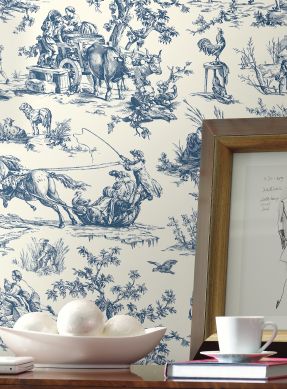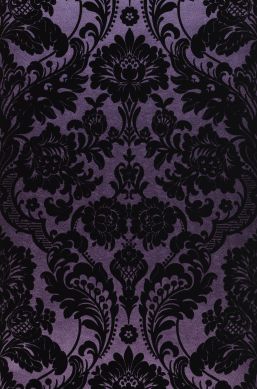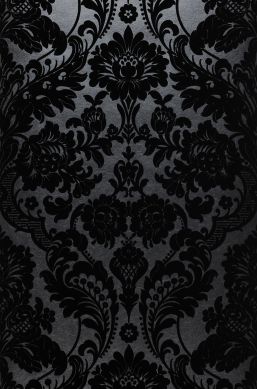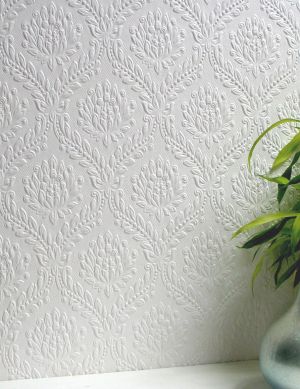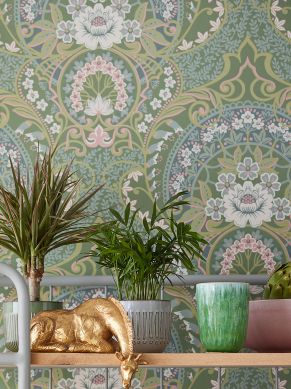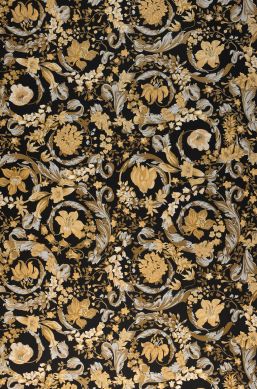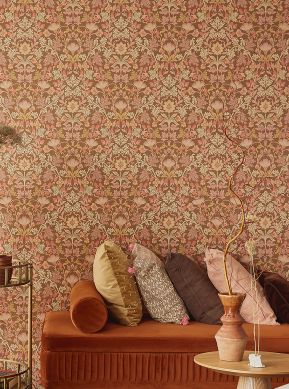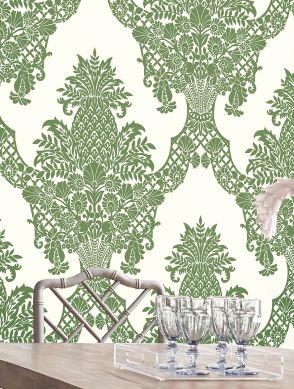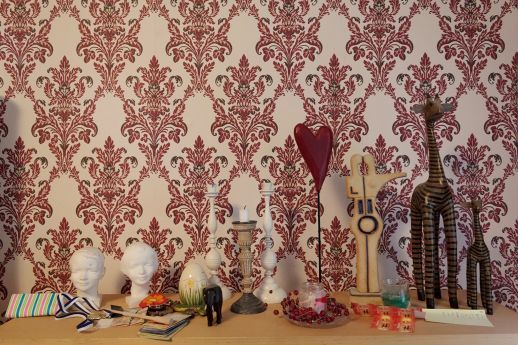Damask Wallpaper
Damask & Baroque Wallpaper: The Guide
Damask wallpaper models with Baroque-style patterns represent beauty, splendour and luxury. They are a timeless and perennially fashionable trend. The main focus lies on impressive ornaments inspired by the imagination, nature, myths and foreign cultures. Exquisite materials, colours and surface structures emphasise the magnificent character of these multi-faceted wallpaper designs. This Guide will introduce you to the wonderful world of damask wallpaper.
Table of Contents
- What does "damask wallpaper" mean?
- Which are the countries of origin that the baroque style can be distinguished by?
- What are the special characteristics of damask and baroque wallpaper?
- Which are the most popular colours of damask wallpaper?
- Which materials are used in the production of contemporary damask wallpapers?
- Which rooms are damask patterns best suited for?
- Which interior design styles are damask wallpapers most suited for?
- Which types of interior design elements can be combined with damask wallpaper?
- Which Baroque artists are the inspiration for baroque wallpaper patterns?
- Our tips: Designing Baroque Art with wallpaper
What does "damask wallpaper" mean?
Damask wallpaper models are inspired by magnificent ornamental decorations and opulent shapes of the European art and style epoch “Baroque”. Chronologically, the Baroque period is divided into Early Baroque, High Baroque, Late Baroque and Rococo, all of which are also represented in wallpaper design.
The Baroque Era
The Baroque style covers the period from 1600 to 1770. Symbolically, it stands for a lavish display of opulence in architecture, art and fashion. Exuberant patterns of detailed multi-faceted ornaments represent unbridled pleasure. Brilliant colours, exquisite materials and ornate patterns are typical of this style epoch.
Early Baroque and High Baroque
Early Baroque developed between 1600 and 1650; High Baroque followed from about 1650 to 1710. Italy, especially Rome, was the cradle and centre of these two phases of the Baroque period. Strong colours and a preference for symmetry characterise the angular patterns which initially were influenced by the Renaissance and which, at the peak of the epoch, culminated in lavish curves and three-dimensional ornaments.
Late Baroque and Rococo
In the 18th century (1710 to 1770), the High Baroque period turned into the Late Baroque. Its most famous form, Rococo, developed in France from about 1720 onwards. Lighter, pastel colours came to the fore, symmetry gave way to freer interpretation, as did the shape of individual elements. One of the most characteristic Rococo patterns is the "rocaille", a shell-shaped ornament which is like the crown of this playful design form.
Which are the countries of origin that the baroque style can be distinguished by?
Within Europe, the Baroque style had various country-specific incarnations. In terms of wallpaper design, the main themes are Italian Baroque, French Baroque and English Baroque.
Italian Baroque
The Italian or Roman Baroque (Barroco) is characterised by a dynamic and theatrical energy with opulent ornaments and illusionistic painting techniques which allowed walls and ceilings to merge seamlessly. The sculptural ceiling paintings of that era, which can be found in Italian churches, castles and palazzos, are world-famous. The most important artists of this period include Michelangelo Merisi da Caravaggio, Guido Reni and Andrea Sacchi.
French Baroque
The heyday and late period of the French Baroque coincided with the reign of Louis XIV, the Sun King. It is characterised by a restrained dynamic and understated ornamentation. However, as in Italy, it takes the combination of all elements to create a Baroque "total work of art". This classicist Baroque style pays homage to lofty and monumental ornamental designs. Under Louis XV, the Rocaille style (which is identical to Rococo) developed. Shell shapes, exuberant ornamentation, asymmetry, light colours and playful lines are its hallmarks.
English Baroque
The English Baroque is an important term in the field of architecture. This comparably sober classicist style is known as "Palladianism". It incorporates a variety of antique components. Flemish artists, above all Sir Anthony van Dyke, are leading in the world of painting and fine arts. The Victorian style, which was prevalent in England from 1837 to 1901, combined several neo-styles, including the Old Baroque. Since it is based on the Louis Quinze style, it is also called Victorian Rococo.
What are the special characteristics of damask and baroque wallpaper?
During the Baroque era, splendour, power and glory were defined by corresponding design features. In wallpaper design, the damask style is reflected by varied ornaments, glitter or even three-dimensional reliefs.
Ornaments
Damask wallpaper design is characterised by opulent ornaments which come in a huge variety of shapes and forms. Floral motifs such as tendrils and flowers, geometric elements or oriental pattern designs are important elements of this opulent style. As befits the age of extravagant luxury, the designs are often large-scale and flamboyant.
Glitter
Glitter and sparkle emphasise the magnificent character of damask designs. In terms of wallpaper, glittering colours such as gold and silver, sparkly details or shimmering materials such as glass beads serve this purpose.
Relief
Plasticity is an important element in damask wallpaper design. In the Italian High Baroque, forms and levels flow into each other via multidimensional representations and form a "total work of art". Damask wallpaper models are characterised by embossed textures and tangible reliefs, which also include striking 3D representations.
Which are the most popular colours of damask wallpaper?
In the world of damask wallpapers, colours can be strong and shimmering or pastel and light. Black, white, blue, red, silver and gold are among the absolute favourites of designers and design fans.
Grey
This neutral mix of black and white puts damask wallpaper models in a new light. Light/dark aspects and clear contrasts determine whether the pattern appears heavy and glamorous or light and elegant like a beam of sunshine. In combination with grey, bright pattern colours are beautifully emphasised.
Black
Black damask wallpaper sets the focus on the magnificent pattern. A magical aura is created when black is combined with gold, silver or other metallic colours. Black stands for depth, mystery and extravagance. A feature wall in a black damask design is often sufficient to create an impressive effect.
White
In colour psychology, white symbolises purity, clarity and innocence. Damask patterns in (or with) white reflect these aspects perfectly - the icing on the cake for any elegant ambience. Damask designs in black and white are exceedingly modern and have a surreal effect.
Blue
Blue is the colour of imagination and relaxation, it stands for the freshness of the ocean and the expanse of the sky. Dark blue has an irresistibly sophisticated character. Bright royal blue is known as the colour of kings and nobility. As a result, blue patterns on damask wallpaper appear majestic and representative.
Green
In colour psychology, green stands for growth, renewal and hope. Damask wallpaper designs in light or dark green can create a natural or unusual effect in the room. Green also stands for unconventional beauty that unfolds in the eye of the beholder and gives damask wallpaper models a refreshing touch.
Red
Crimson - the most dazzling and expensive red with which the crowned heads of the high nobility like to adorn themselves - is one of the most exciting colours of the Baroque era. Red is generally considered to be a stimulating, beguiling and seductive colour, which reflects the joie de vivre that characterised the Baroque era. Wine red or Bordeaux are sought-after colours for damask wallpaper patterns, too.
Cream
Delicate cream is a colour tone composed of white, yellow and red/brown components. In terms of damask wallpaper, it provides a softening character. Cream gives even the most conspicuous patterns a delicate appearance with a touch of mystery. This shade appears warm, friendly and very cosy.
Silver
Silver is like the less gaudy sister of gold. This popular metal colour has a cool and elegant aura as well as a harmonising and balancing effect. The inherent shine of silver emphasises other colours and is the perfect partner colour for damask pattern designs. Such wallpaper patterns in silver nuances are original, unconventional and expressive.
Gold
Gold is the number one colour for opulent damask design. The colour of the sun outshines everything else. Gold creates a powerful dynamic in the room; it bursts with confidence and provides inspiration. Choosing gold damask wallpaper means introducing the luxury factor into one's home.
Which materials are used in the production of contemporary damask wallpapers?
The most advanced materials can work beautifully with historical style models, as damask wallpapers prove. Non-woven, flock, textile and vinyl are the main materials used in the production of gorgeous damask-style wallpapers.
Non-woven material
Both the surface and the backing layer of modern damask wallpaper models can consist of non-woven material. Non-woven wallpaper is robust, easy to hang and can be removed in a dry state without leaving any residue behind. Wallpaper surfaces made from non-woven material can be designed in a large variety of ways to create visually and haptically impressive damask designs.
Flock
Flock is a fluffy surface material consisting of ultra-short viscose fibres which are glued to the carrier layer by means of electrostatic charge. Velvet fibres are often used for a unique haptic experience. Damask patterns made by flocking create a sophisticated, warm and sensual ambience.
Textile
Synthetic or natural textile fibres are the basis for exclusive surfaces that befit the damask style. These are applied to the carrier material - either lengthwise in the shape of warp threads, or as fabric. Silk, damask and brocade are used to create authentic fabric wallpapers reminiscent of those used to decorate the castle walls of kings and queens.
Vinyl
Easy-care and washable vinyl wallpapers reflect the Baroque lifestyle even in very busy areas such as kitchens or bathrooms. Wallpaper types with a synthetic surface can also be embossed in many different ways. In damask wallpaper design, for example, beautiful, tactile and three-dimensional reliefs are commonplace.
Which rooms are damask patterns best suited for?
Damask wallpaper motifs are a feast for the eyes and work perfectly with both classic and ultra-modern styles. Wallpaper models in a Baroque style are most suitable for living rooms, bedrooms and hallways.
Living room
The living room can be a completely private retreat and still have a representative character for guests who come to visit. The room can be furnished in the original Baroque style, but a damask design wallpaper also provides the basis for a wide variety of other looks, e.g. Shabby and Sophisticated Chic.
Bedroom
"You made your bed, now sleep in it." Damask design wallpaper opens up magical opportunities for a luxurious boudoir, be it on just one (feature) wall or all four walls. Bed canopies, chandeliers, draped curtains and matching accessories create the perfect upscale ambience.
Hallway
Eye-catching splendour, chic understatement or luxurious elegance reflecting a certain attitude to life - all these are good reasons for using damask wallpaper in hallways. Baroque-style patterns guarantee an unforgettable, positive first impression in the reception area. Type, size and colours of the pattern should match the room parameters.
Which interior design styles are damask wallpapers most suited for?
Damask design wallpapers are versatile combination partners for many interior design concepts. They work with modern as well as classic or luxurious furnishing styles and complement whimsical vintage looks.
Modern
Neo-Baroque wallpaper models make use of new ornaments and colour concepts that are perfect for extroverted modern interior design ideas. They represent a high degree of individuality and independence from the mainstream. On the other hand, classic, elaborate baroque patterns on the wall are also an exotic counterpart to modern furniture.
Classic styles
The classic furnishing style finds its origins in the great epochs of Rococo, Art Nouveau and Art Deco. The contemporary version is an elegant style that makes use of elements from historical eras (including the Baroque). This hip style mix with a personal touch is characterised by premium-quality materials and light colours.
Luxurious
Luxury is represented by materials such as velvet, silk, marble, gold and silver. Damask wallpapers are a great way to mirror the opulent lifestyle at European royal courts. Premium-quality damask wallpapers in the style of the Baroque era are simply perfect for the design of luxurious interiors.
Vintage
Damask wallpapers in subtle or bright colours and multi-faceted patterns first found their way into many homes during the 1970s. They adorned countless walls, from teenagers' rooms to basement party dens. In the 1980s, the classic style was often emphasised with baroque design patterns. Consequently, cool vintage looks often benefit from damask design wallpaper.
Which types of interior design elements can be combined with damask wallpaper?
Despite the fact that damask wallpaper is always an eye-catcher, in order to create a fabulous ambience it needs other elements. Curtains, furniture fabrics, borders or striped wallpaper are all suitable combination partners for stylish interiors.
Curtains
Flowing, extra-long curtains made of velvet, brocade or silk, perfectly draped and fixed with tassels, beautify windows, doorways or even four-poster beds. Modern window frames can be concealed by valances, adding to the comfort factor.
Furniture fabrics
Premium upholstery and furniture fabrics made of brocade, jacquard, damask or tapestry underline the luxurious character of a typical Baroque-style ambience. Comfort is another important feature of this interior design style, which is why upholstered seating furniture is a must. In addition to plain-coloured, shiny fabrics, there are upholstery fabrics with ornamental patterns that pick up on the colour and motifs of the wallpaper.
Borders
Borders or trims are the decorated edges or woven edges of fabrics, textiles, carpets and wallpaper. This additional decorative element emphasises the exuberant aspect of baroque design furnishings and, in terms of wallpaper, has a functional factor, too. They make it possible to create clean and effective wallpaper edges or transitions.
Striped wallpaper
Wallpaper models with a stripe design and damask patterns go very well together, especially if the pattern colours of both models are identical or from similar colour families. The width and direction of the stripes should be adapted to the size of the pattern to avoid visual disharmonies.
Which Baroque artists are the inspiration for baroque wallpaper patterns?
Famous Italian and Dutch painters of the Baroque period still inspire designers around the globe to create unique damask wallpaper patterns. First and foremost amongst them are Caravaggio, Peter Paul Rubens, Rembrandt and Jan Vermeer.
Caravaggio
Michelangelo Merisi (1571 - 1610), named Caravaggio after his parents' home village, was one of the founders of Roman Baroque painting. His works around Christian themes are characterised by chiaroscuro painting, which was considered a major innovation at the time. Renowned artist Caravaggio painted many of the Roman cardinals; he was the darling of the Neapolitan nobility and knight of the Order of Malta.
Peter Paul Rubens
Flemish painter Peter Paul Rubens (1577 - 1640), who was born in Germany, is world-famous for his exuberant, curvy depictions of female bodies which inspired the term "Rubenesque". The opulent and round shapes of the Baroque era symbolise fullness and health, which is why round, curvy forms are an elementary stylistic device. These aspects and the pathos of the artist's paintings make Rubens one of the foremost painters of the Baroque period.
Rembrandt
Rembrandt van Rijn (1606 - 1669), or Rembrandt in short, is one of the most important representatives of Baroque art. His oeuvre is dominated by historical paintings and portraits, including the world-famous "Night Watch". With its narrative character, his vivid, three-dimensional pictorial language impressed contemporary art enthusiasts, as did the gigantic formats of his works.
Jan Vermeer
Jan Vermeer (1632 - 1675) is one of the best known Dutch painters of the Baroque era, even though his work of historical and genre paintings comprises only 37 pictures in total. The detailed accuracy with which he depicts what he sees is breath-taking. His works allow us to draw very precise conclusions about the fashion, patterns, fabrics and textures of the Baroque period.
Our tips: Designing Baroque Art with wallpaper
- Versace Neo-Baroque: The extremely multi-faceted range of designer label Versace includes wallpaper models in the new Baroque style which boast many surprise elements and yet remain true to the historical line. Anything from angular ornaments and mythical figures to classic floral tendril patterns is represented. Metallic colours, gold, black and silver are the preferred colours in Versace's Baroque universe.
- Baroque & Roses: True romantics will love the combination of rose patterns and damask designs. Combining a magnificent damask wallpaper in gold and champagne with curtains printed with delicate colourful rose petals is a fabulous style choice. Adding bed linen with rose prints, a still life with roses in an antique gold frame or a rose motif carpet make the romantic ambience perfect.
- Baroque-style toilets: During the Baroque era, aristocrats knew how to spend their "time out" in style and in a manner befitting their status. Dare to introduce a touch of that decadence into your WC. From black/white Baroque-style designs to black/gold damask patterns, to strong shades of blue and red or rainbow colours - everything that adds an exotic touch is perfect for damask wallpaper. Don't forget matching accessories such as decorative mirrors, statuettes and pictures of historical personalities.
- Industrial meets Baroque: The rough urban charm of old factory buildings meets antique Baroque. As is well known, opposites attract - and in this case, the contrasts could not be more interesting. Rusty metal and rough concrete are combined with faded Baroque-style ornaments in a tarnished silver tone. Sober industrial design sits comfortably next to an elaborate Baroque sofa upholstered with velvet.






